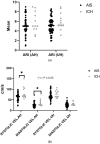A Multi-Parametric Approach for Characterising Cerebral Haemodynamics in Acute Ischaemic and Haemorrhagic Stroke
- PMID: 38786378
- PMCID: PMC11120760
- DOI: 10.3390/healthcare12100966
A Multi-Parametric Approach for Characterising Cerebral Haemodynamics in Acute Ischaemic and Haemorrhagic Stroke
Abstract
Background and purpose: Early differentiation between acute ischaemic (AIS) and haemorrhagic stroke (ICH), based on cerebral and peripheral hemodynamic parameters, would be advantageous to allow for pre-hospital interventions. In this preliminary study, we explored the potential of multiple parameters, including dynamic cerebral autoregulation, for phenotyping and differentiating each stroke sub-type.
Methods: Eighty patients were included with clinical stroke syndromes confirmed by computed tomography within 48 h of symptom onset. Continuous recordings of bilateral cerebral blood velocity (transcranial Doppler ultrasound), end-tidal CO2 (capnography), electrocardiogram (ECG), and arterial blood pressure (ABP, Finometer) were used to derive 67 cerebral and peripheral parameters.
Results: A total of 68 patients with AIS (mean age 66.8 ± SD 12.4 years) and 12 patients with ICH (67.8 ± 16.2 years) were included. The median ± SD NIHSS of the cohort was 5 ± 4.6. Statistically significant differences between AIS and ICH were observed for (i) an autoregulation index (ARI) that was higher in the unaffected hemisphere (UH) for ICH compared to AIS (5.9 ± 1.7 vs. 4.9 ± 1.8 p = 0.07); (ii) coherence function for both hemispheres in different frequency bands (AH, p < 0.01; UH p < 0.02); (iii) a baroreceptor sensitivity (BRS) for the low-frequency (LF) bands that was higher for AIS (6.7 ± 4.2 vs. 4.10 ± 2.13 ms/mmHg, p = 0.04) compared to ICH, and that the mean gain of the BRS in the LF range was higher in the AIS than in the ICH (5.8 ± 5.3 vs. 2.7 ± 1.8 ms/mmHg, p = 0.0005); (iv) Systolic and diastolic velocities of the affected hemisphere (AH) that were significantly higher in ICH than in AIS (82.5 ± 28.09 vs. 61.9 ± 18.9 cm/s), systolic velocity (p = 0.002), and diastolic velocity (p = 0.05).
Conclusion: Further multivariate modelling might improve the ability of multiple parameters to discriminate between AIS and ICH and warrants future prospective studies of ultra-early classification (<4 h post symptom onset) of stroke sub-types.
Keywords: baroreflex sensitivity; blood-flow velocity; cerebral autoregulation; stroke; transcranial doppler sonography.
Conflict of interest statement
The authors declare that the research was conducted in the absence of any commercial or financial relationships that could be construed as a potential conflict of interest.
Figures
References
-
- Johnson C.O., Nguyen M., Roth G.A., Nichols E., Alam T., Abate D., Abd-Allah F., Abdelalim A., Abraha H.N., Abu-Rmeileh N.M., et al. Global, regional, and national burden of stroke, 1990–2016: A systematic analysis for the Global Burden of Disease Study 2016. Lancet Neurol. 2019;18:439–458. doi: 10.1016/S1474-4422(19)30034-1. - DOI - PMC - PubMed
-
- Adams H.P., Jr., del Zoppo G., Alberts M.J., Bhatt D.L., Brass L., Furlan A., Grubb R.L., Higashida R.T., Jauch E.C., Kidwell C., et al. Guidelines for the early management of adults with ischemic stroke: A guideline from the American Heart Association/American Stroke Association Stroke Council, Clinical Cardiology Council, Cardiovascular Radiology and Intervention Council, and the Atherosclerotic Peripheral Vascular Disease and Quality of Care Outcomes in Research Interdisciplinary Working Groups: The American Academy of Neurology affirms the value of this guideline as an educational tool for neurologists. Stroke. 2007;38:1655–1711. - PubMed
-
- Lees K.R., Bluhmki E., von Kummer R., Brott T.G., Toni D., Grotta J.C., Albers G.W., Kaste M., Marler J.R., Hamilton S.A., et al. Time to treatment with intravenous alteplase and outcome in stroke: An updated pooled analysis of ECASS, ATLANTIS, NINDS, and EPITHET trials. Lancet. 2010;375:1695–1703. doi: 10.1016/S0140-6736(10)60491-6. - DOI - PubMed
LinkOut - more resources
Full Text Sources




